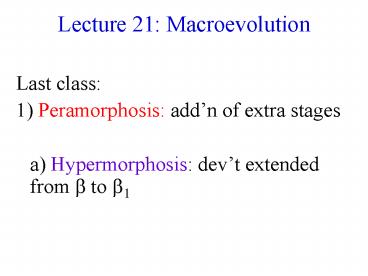Lecture 21: Macroevolution - PowerPoint PPT Presentation
Title:
Lecture 21: Macroevolution
Description:
a) Hypermorphosis: dev't extended from to. 1 b) Predisplacement: y ... Wrasse & Angelfish. Skulls of Human, Chimp & Baboon. Evolution of Higher Taxa (Gould) ... – PowerPoint PPT presentation
Number of Views:63
Avg rating:3.0/5.0
Title: Lecture 21: Macroevolution
1
Lecture 21 Macroevolution
- Last class
- 1) Peramorphosis addn of extra stages
- a) Hypermorphosis devt extended from ? to ?1
2
b) Predisplacement
- y starts growing early rel. to x in descendent
vs. ancestor
3
c) Acceleration
- faster growth of y rel. to x in descendent vs.
ancestor
Descendant Ancestor
?1
?
log y
Larger (or more devd) y (not x) at maturity
?
log x
4
2) Paedomorphosis
- retention of juvenile features in adult
- A) Progenesis
- B) Neoteny
- C) Postdisplacement
5
a) Progenesis
- devt stops early
6
b) Neoteny
- slower rate of growth of y rel. to x in
descendant vs ancestor
7
c) Postdisplacement
- y starts growing late rel. to x in descendant vs.
ancestor
Ancestor Descendant
?
?1
log y
- same allometry - late start of y means smaller
y (not x) at maturity
?
?1
log x
8
(No Transcript)
9
Evolutionary Significance of Heterochrony?
- 1. Large changes in phenotypes easily
accomplished - - mutations at one or several loci may be
involved - 2. Likely important in speciation
- gene pools w diff. heterochronic mutations
- ? repro. isoln
10
- 3. May release lineages from phylogenetic
constraints - - e.g. paedomorphosis descendant no longer
passes through the same developl stages as
ancestor - - can free the sp. from the constraint imposed
by that structure - - only affects existing structures.
11
Genetic Basis of Heterochrony
- Homeotic (Hox) genes
- 1st discovered in Drosophila spp.
- involved in gross alterations in phenotype
- Affect developt of cuticular structures from
imaginal disks - in all animal phyla
- share of common
- characteristics
- e.g. antennapedia
12
Hox Genes
- 1. organized in gene complexes
- - probably involves gene duplication
- 2. spatial temporal collinearity
- - 3' end expressed anterior 5' end expressed
posterior - - 3' end expressed earlier in devt than 5' end
13
Hox Genes contd
- 3. contain highly-conserved 180 bp region
- - involved in binding
- Hox genes are regulators - control timing and
expression of other genes - e.g. Ubx (ultrabithorax) in Drosophila controls
expression of 85 - 170 genes
14
Type of Heterochronic Process?
- Axolotl
- vs. Tiger Salamander
- failure to metamorphose
- thyroxine can be exptally induced
- external gills in adult (juvenile morphology)
15
So whats going on?
- not postdisplacement age at maturity other
salamanders - not progenesis body size at maturity other
salamanders (progenesis ?tiny adult) - Neoteny somatic devt slows is overtaken by
normal sexual maturity ? giant juvenile
16
DArcy Thompson
- early 20th century
- comparative anatomist
- On Growth Form transformation grids
- explain changes in shape determine allometric
growth - measurements made plotted on rectangular
coordinates - same measurements made in a related organism or a
different stage in devt - shown as deformations of grid system
- now partial warp analysis
17
Hatchetfish
Wrasse Angelfish
Skulls of Human, Chimp Baboon
18
Evolution of Higher Taxa (Gould)
- new groups often arise from neotenic or
progenetic ancestors - e.g. flightless birds
- e.g. insects from larval form of millipede-like
ancestor? - e.g. chordates ?larval condn of tunicates?
19
Saltationists
- distinctive features of higher taxa arise through
systemic mutation (complete reorganization) - Argument
- - few intermediates among higher taxa
- - little selective advantage to incipient
structures - - results in dramatic, discontinuous effects
20
Neodarwinists
- Counter-argument
- - characters of higher taxa evolve mosaically
- - many intermediate forms
- e.g. Archaeopteryx, Lepidoptera
- - early stages of complex structures selectively
advantageous - - mutations with disruptive pleiotropic effects
usually fatal (no change in rate)































